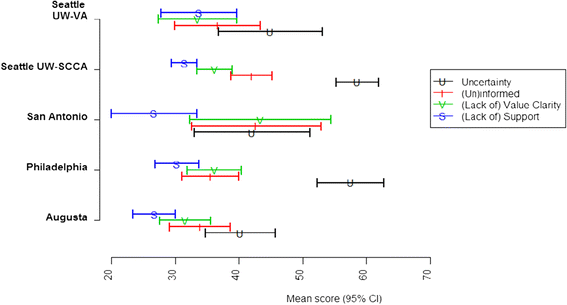When study site contributes to outcomes in a multi-center randomized trial: a secondary analysis of decisional conflict in men with localized prostate cancer
- PMID: 25344101
- PMCID: PMC4213457
- DOI: 10.1186/s12955-014-0159-3
When study site contributes to outcomes in a multi-center randomized trial: a secondary analysis of decisional conflict in men with localized prostate cancer
Abstract
Purpose: Evaluate baseline factors that may explain the influence of study site on decisional conflict (DC) in men from the Personal Patient Profile: Prostate (P3P) randomized trial.
Materials and methods: 476 cases from 5 P3P sites were included. Participants completed baseline demographic assessments, 4 subscales of the DC scale at baseline (uncertainty, informed, values clarity, and support), the Expanded Prostate Cancer Index Composite (short form) and the State-Trait Anxiety Inventory. Site data regarding typical practices were collected. Linear regressions were used to model the relation between baseline DC scores and study site adjusting for the list of variables.
Results: Baseline decisional uncertainly (p = 0.001) and informed (p = 0.03) subscales were significantly different across sites. Participant demographic and baseline measures were significantly different (p < 0.05) between sites except for trait anxiety. We identified participant level factors that explained study site differences at baseline for the decisional uncertainty and values clarity subscales: a preferred treatment choice at study entry, whether the study program was accessed at home vs. in clinic, number of doctors consulted pre-study, working status, state anxiety, information from the media or a health care provider, and perceived knowledge level. State anxiety was associated with higher DC across all subscales.
Conclusions: Individual characteristics of men seeking consultation for LPC were associated with DC at baseline, not the site alone; anxiety contributed to higher conflict. These findings will inform future development and implementation of the P3P and other decision support interventions.
Trial registration: NCT00692653.
Figures

References
-
- American Cancer Society . Cancer Facts and Figures 2014. Atlanta: American Cancer Society; 2014.
Publication types
MeSH terms
Associated data
Grants and funding
LinkOut - more resources
Full Text Sources
Other Literature Sources
Medical

